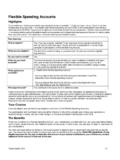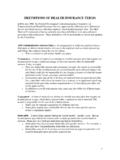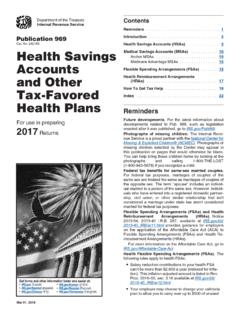Transcription of Sections 125 and 223 – Cafeteria Plans, Flexible Spending ...
1 1 Sections 125 and 223 Cafeteria Plans, Flexible Spending Arrangements, and Health Savings Accounts Elections and Reimbursements for Same-Sex Spouses Following the Windsor Supreme Court Decision Notice 2014-1 I. PURPOSE This notice provides guidance on the application of the rules under section 125 of the Internal Revenue Code (Code) (relating to Cafeteria plans, including health and dependent care Flexible Spending arrangements (FSAs)), and section 223 of the Code (relating to health savings accounts (HSAs)), as those two provisions relate to the participation by same-sex spouses in certain employee benefit plans following the Supreme Court decision in United States v.
2 Windsor, 570 ___, 133 S. Ct. 2675 (2013), and the issuance of Rev. Rul. 2013-17, 2013-38 201. This notice amplifies the previous guidance provided in Rev. Rul. 2013-17. II. BACKGROUND A. Cafeteria Plans, Health and Dependent Care FSAs, and HSAs Section 125(d)(1) defines a Cafeteria plan as a written plan under which all participants are employees and the participants may choose among two or more benefits consisting of cash and qualified benefits. Section 125(f) defines a qualified benefit as any benefit which, with the application of section 125(a), is not includable in the gross income of the employee by reason of an express provision of Chapter I of the Code (with certain exceptions).
3 Qualified benefits include contributions to an employer-provided accident and health plan that are excludable from gross income under section 106. Under Treas. Reg. , the gross income of an employee does not include contributions that his employer makes to an accident or health plan for compensation (through insurance or otherwise) to the employee for personal injuries or sickness incurred by the employee, the employee s spouse and dependents, and certain other individuals. Treas. Reg. provides that a Cafeteria plan may permit an employee to revoke an election during a period of coverage and make a new election under certain circumstances.
4 One circumstance under which a Cafeteria plan may permit an employee to make a new election is a change in status event under Treas. Reg. (c), including a change in legal marital status. Another circumstance under which a Cafeteria plan may permit an employee to make a new election is a significant change in the cost of coverage under Treas. Reg. (f). Prop. Treas. Reg. defines a FSA as a benefit program that provides 2employees with coverage that reimburses specified incurred expenses (subject to reimbursement maximums and any other reasonable conditions).
5 Prop. Treas. Reg. (h) provides that the benefits that may be offered through FSAs include dependent care assistance programs under section 129 and medical reimbursement arrangements under section 105. Section 129 provides that the maximum exclusion from gross income under a dependent care assistance program is $5,000 for an individual or a married couple filing jointly or $2,500 for a married individual filing separately. Section 223(d) defines a HSA as a trust created or organized in the United States as a health savings account exclusively for the purpose of paying the qualified medical expenses of the account beneficiary and that satisfies other delineated requirements.
6 The term qualified medical expenses is defined in section 223(d)(2) to include amounts paid by a beneficiary for medical care for that individual and the spouse of that individual. Section 223(a) allows a deduction for an eligible individual in an amount equal to the aggregate amount paid in cash during a taxable year by or on behalf of the individual to a HSA. The maximum deduction for the 2013 taxable year is limited to $6,450 (as adjusted for cost-of-living increases) in the case of an eligible individual who has family coverage under a high-deductible health plan (HDHP); see Rev.
7 Proc. 2012-26, 2012-20 933. In the case of married individuals either one of whom has family coverage under a HDHP, the HSA deduction limitation is divided equally among the spouses unless they agree on a different division. B. Defense of Marriage Act Until the recent decision of the Supreme Court in Windsor found it unconstitutional, section 3 of the Defense of Marriage Act (DOMA) prohibited the recognition of same-sex marriages for purposes of federal tax law. Specifically, section 3 of DOMA (1 7) provided that: In determining the meaning of any Act of Congress, or of any ruling, regulation or interpretation of the various administrative bureaus and agencies of the United States, the word marriage means only a legal union between one man and one woman as husband and wife, and the word spouse refers only to a person of the opposite sex who is a husband or a wife.
8 As a result, employers could not permit employees to elect coverage of same-sex spouses on a pre-tax basis under a Cafeteria plan unless the spouse otherwise qualified as a tax dependent of the employee. C. Effect of the Windsor decision and Rev. Rul. 2013-17 In Windsor, the Supreme Court held on June 26, 2013 that section 3 of DOMA is unconstitutional because it violates Fifth Amendment principles. Rev. Rul. 2013-17, interpreting the Windsor decision, held the following: 3 1. For Federal tax purposes, the terms spouse, husband and wife, husband, and wife include an individual married to a person of the same sex if the individuals are lawfully married under state law, and the term marriage includes such a marriage between individuals of the same sex; 2.
9 For Federal tax purposes, the IRS adopts a general rule recognizing a marriage of same-sex individuals that was validly entered into in a state whose laws authorize the marriage of two individuals of the same sex even if the married couple is domiciled in a state that does not recognize the validity of same-sex marriages; and 3. For Federal tax purposes, the terms spouse, husband and wife, husband, and wife do not include individuals (whether of the opposite sex or the same sex) who have entered into a registered domestic partnership, civil union, or other similar formal relationship recognized under state law that is not denominated as a marriage under the laws of that state, and the term marriage does not include such formal relationships.
10 Rev. Rul. 2013-17 provides that taxpayers may rely on its holdings retroactively with respect to any employee benefit plan or arrangement or any benefit provided thereunder only for purposes of filing original returns, amended returns, adjusted returns, or claims for credit or refund of an overpayment of tax concerning employment tax and income tax with respect to employer-provided health coverage benefits or fringe benefits that were provided by the employer and are excludable from income under Sections 106, 117(d), 119, 129, or 132 based on an individual s marital status.
















